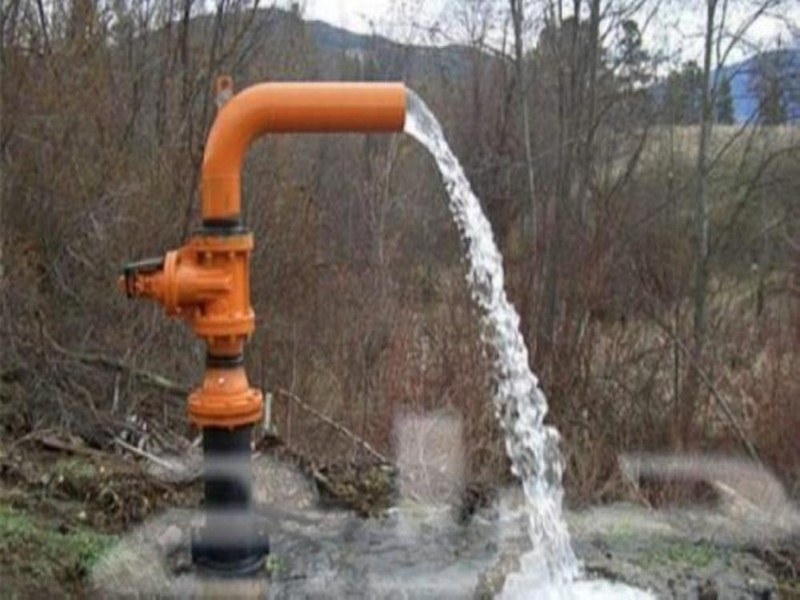
The importance of groundwater to the Kingdom’s water plan
The importance of groundwater stems from being one of the most important sources of drinking water in the Kingdom. Saudi Arabia is one of the driest regions in the world, with no permanent rivers. Water is obtained from four different sources, 40% of which is groundwater. Since it is a non-renewable source of water, it had to be taken care of and preserved, and other means should be sought.
Groundwater sources
Groundwater is located within natural reservoirs in the ground, which is a rocky or sedimentary layer capable of containing an amount of water. It consists of unconsolidated materials such as sand and gravel, or compacted rocks such as sandstone or limestone, or voids and crevices between soil grains.
There are several sources of groundwater, including:
Rainwater
The main source of groundwater is rainwater, where part of this water collects on the surface of the earth, while part of the rainwater filters through the pores and cracks of the earth and collects in the ground. In the form of fixed tanks, which are then transformed into water basins.
Mineral and sulfur water
Part of the nearby lakes or rivers leak and basins accumulate in the ground and remain imprisoned. They cannot be accessed or benefited from except by digging wells.
Semolina water
It is the water that rises to the top after the various stages of magma crystallization.
Coupled water
It is the water that accompanies the process of sediment formation in the early stages and is trapped between its parts and pores.
The amount of groundwater available
Modern science has been able to determine the amount of fresh groundwater in the world, which is much greater than that available above the surface of the earth. Of the total water on Earth, including fresh and salt water. It is worth mentioning here that the groundwater may be renewable and current under the surface of the earth, forming a network of streams and rivers in which the water maintains its level despite the continuous intake of it because of its permanent feeding with rainwater that falls permanently or through the waters of rivers and lakes that permeate the soil and reach this Groundwater, or groundwater may be non-renewable, so its level gradually decreases according to what is consumed from it, and this water is often groundwater that gathered in the ground in previous centuries and rainy eras, but it is not connected to renewable sources of water, and its characteristics are distinct from the rest of the groundwater as a result Its presence in the ground since many times, we mention among these characteristics the high temperature and the increase in its content of salts and dissolved gases.
Groundwater sometimes does not need to dig wells for its emergence, as it may erupt in the form of springs and springs as a result of the increase in pressure on it in the ground or the pressure of the earth’s crust in this place, and water may flow from the spring in the form of a fountain as a result of the increase in pressure applied to this water or the pressure decreases so it flows The water flowing on the surface of the earth in streams that are carved and cut by this water, which may be hot, deriving its heat from the high temperature of the earth’s interior or as a result of its proximity to places with volcanic activities, or it may be cold as a result of its exit from layers close to the surface of the earth.
What is groundwater pollution?
Definition of water pollution The World Health Organization (WHO) defined water pollution as any change that occurs to the elements included in its composition, directly or indirectly, due to human activity, which makes this waterless fit for the natural uses allocated to it or some of it. In other words, it is the changes that occur in the characteristics of water. Natural, biological, and chemical water, which makes it unsuitable for drinking or for domestic, industrial, and agricultural uses.
Groundwater pollution affects the quality of groundwater not only human health but also society and the national economy. It is used in agriculture, in providing drinking water for humans and animals, and in the industry in many operations such as cooling and disposal of industrial waste. It is also used in energy production and exploration. Oil and for heating and cooling purposes in addition to various other uses.
What is groundwater pollution?
For many years, humans believed that groundwater was naturally protected from contamination by layers of rock and soil that act as filters. However, the problem of urban expansion and widespread and unregulated industrialization processes has led to pollution of water in general and groundwater in particular, which is difficult to clean because it is a tedious and expensive process.
The recklessness of people in their dealings with groundwater, even in the most developed countries of the world, including the United States of America, which provides more than half of the drinking water for its entire population, led to the start of the pollution problem since the seventies, and in the period from 1971 to 1985, an outbreak of more than 245 water-related diseases was recorded. Groundwater data indicated by the US Environmental Protection Agency (EPA) that 10% of all drinking water supply networks from groundwater violate clean drinking water standards as a result of biological pollution. It has discovered 74 types of pesticides, including types that cause cancer, in 38 US states. The biological pollution of groundwater has also spread, such as contamination with bacteria, viruses, and parasites such as the Cryptosporidium parasite that infects the intestines, as there have been 6 cases of epidemic spread of this parasite due to groundwater contamination.
Sources of groundwater pollution
There are many sources causing groundwater pollution, some of which are due to natural factors, and some are due to a range of human activities. The sources of pollution resulting from human activities can be divided into the following:
Agricultural sources of pollution
There are many sources of agricultural pollution, including:
Agricultural pesticides, fertilizers, and soil conditioners such as lime, gypsum, and sulfur, part of which seeps into the groundwater.
Waste, animal residues, and pollution with agricultural wastewater lead to an increase in the concentration of calcium and calcium salts, magnesium, sodium, sulfates, chlorine, nitrates, and finally the use of chemical fertilizers, especially nitrogen, phosphorous, and potassium.
Fertilizers and pesticides leak directly into the ground while handling them. Leakage caused by loading and washing pesticide spraying equipment.
Leakage resulting from storing agricultural chemicals in open areas without protection from wind and rain. Mixing and spreading pesticides and fertilizers with irrigation water leads to groundwater pollution if the amount of these chemicals is greater than the plant’s need. Misuse of these pesticides and fertilizers by farmers may lead to the contamination of groundwater with many organic compounds and elements such as nitrogen, cadmium, chlorine, mercury, and selenium.
As for animal waste, it can contaminate groundwater aquifers with nitrates, coliform bacteria, dissolved solids, and sulfates.
Irrational handling of agricultural machinery and machinery causes contamination of groundwater with dyes that contain lead and barium), gasoline and lubricating oils that contain volatile organic compounds, diesel fuel that contains barium, in addition to rinsing fluids that contain pesticide residues and fertilizers.
Household pollution sources
Sewage effluent from homes is a major source of groundwater pollution, as it causes a wide variety of pollutants including bacteria, viruses, nitrates from household waste, and organic compounds. Chemicals stored improperly in homes or disposed of with wastewater (dyes, cleaning fluids, oils, medicines, disinfectants, etc.) can be a serious source of groundwater pollution, and the risk of these pollutants increases when leakage occurs in the drainage networks. sanitation, or in the case of direct underground drainage that causes the following problems:
- Pollution of rivers and shallow groundwater.
- Pollution of beaches and coastlines.
- Destruction of marine organisms.
- Surface water pollution by eutrophication.
Solid waste reservoirs that pollute the water with harmful elements such as iron, manganese, chlorine, nitrates, and harmful gases such as methane, carbon dioxide, ammonia, and hydrogen sulfide gas
With the large expansion in the size of modern residential neighborhoods and in the road networks, rainwater becomes an additional source of groundwater pollution by taking with it from the roofs of houses and open places in them and from the streets of polluting materials into the ground, including sodium, lead, and organic compounds from oils, gasoline, cleaning fluids, and grease solvents. Also, household waste infects groundwater with many pollutants, including:
- Industrial detergents are used to wash dishes and clothes.
- Organic compounds in household waste.
- Bacteria, nitrates, and sulfates in sewage.
- Various air fresheners contain carbon tetrachloride.
- Oils, greases, and cleaning fluids.
Industrial sources of pollution
Modern economic activities require the transportation and storage of materials used in manufacturing, processing, and construction. These materials can find their way into the groundwater through leakage, spillage, or improper handling.
What is more, the cleaning of these materials can also cause a threat to the groundwater when these materials move with the cleaning water into the ground. Many industrial and service facilities are not connected to the sewage network, so they throw their waste directly into the ground or into pits prepared for that. Among the most dangerous of these facilities are the following:
- Car cleaning and repair stations, clothes cleaning shops, photo development laboratories, and factories.
- Electrical tools and their components because their waste includes toxic chemicals, even in large facilities connected to sewage networks, the small quantities of their waste leaking into the ground
- Quite a few long-term threats to groundwater.
- Leakage of petroleum and chemicals from tanks, boats, and pipeline networks.
- Mining wastes (coal mines, uranium phosphate, iron …) that pollute surface and groundwater.
- Radioactive waste is one of the most serious problems of water pollution in general and ground and mineral water in particular, as it contains highly toxic substances that cause various diseases, the most important of which is cancer.
Natural sources of pollution
Pollution can sometimes reach groundwater without human involvement in it. It depends on the geological structure of the earth’s layers through which groundwater moves through rocky and muddy layers that contain a wide range of elements such as magnesium, calcium, and chlorine.
The inner walls of the aquifers contain naturally high concentrations of soluble components such as arsenic, boron, and selenium. The impact of these natural sources of pollution depends on the type and concentration of the pollutants.
Among the elements in the soil that can be transformed into pollutants are mentions of aluminum, barium, lead, cadmium, chlorine, mercury, zinc, arsenic, copper, nitrates, iron, and sulfates.
Groundwater may be contaminated with untreated sewage pollutants, which leads to the emission of hydrogen sulfide gas in this water, as a result of leakage from sewage network lines due to their age, as a result of a break in them, or when replacing the new network with an old one, or due to the presence of sanitary absorption holes. An old.
It is very difficult to measure pollution with hydrogen sulfide gas because it is a gas that quickly escapes from the water and because it is not possible to accurately measure it on practical and field tests and analyses. The sense of smell remains the best way to know it.
Read more about the design and construction of a groundwater treatment plant with water care here.
























